The Best Concealed Carry Guns
When it comes to defending yourself and the ones you love, you want to know your concealed carry gun will do the job. From 1911 pistols to revolvers, the concealed carry pistol you choose will have its own special traits. Do you go for aluminum or polymer? Maybe you want something small, yet effective. How about an all-time classic?
We have some recommendations for the best concealed carry guns, whatever your needs, including our STK100, the Rock Ultra CCO 45ACP and the BBR Standard 380ACP.
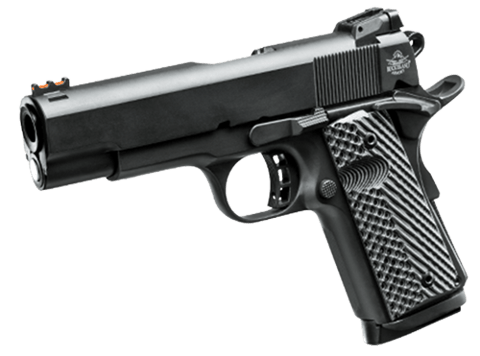
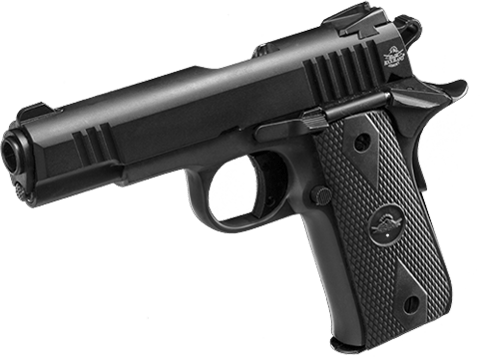
Want to see more?

When will you be carrying?
The route you go with your concealed carry pistol can vary depending upon whether you’re looking to carry mostly while you’re on the job or when you’re off the clock. For some who wear suits to work every day, a larger, more difficult to conceal pistol may not bother them. For others, everyday clothes may prevent them from successfully concealing their pistol. Regardless of which camp you fall into, it’s crucial that you consider the times that you intend to carry your pistol and the situations that you might find yourself in while carrying. Taking the time to think about this ahead of time can save you headaches down the road.

Where do you want to take your concealed carry pistol?
Do you spend more time in wide-open areas or compact spaces? The answer can carry significant weight when picking out your concealed carry pistol.
Larger handguns with longer barrels are more difficult to maneuver around tight corners when you don’t have much room. In contrast, pistols with shorter barrels will struggle for accuracy at longer ranges and they also often pack less of a punch.
Some shooters have desk jobs that don’t require much activity during the day, while others may move around constantly.
If you’re relatively stationary in your office environment, your concealed carry pistol likely won’t have much of an impact on your ability to complete normal tasks. But, for shooters who have more active lifestyles, a more compact, durable concealed carry gun will stay out of your way while enduring the wear and tear caused by your movements. Read more about how and where to concealed carry your pistol.

What size gun to concealed carry?
Your choice for a concealed carry gun will depend on whether you’re looking to carry mostly while you’re on the job or off the clock. If you wear a suit to work every day, a larger pistol might not bother you. Others who wear everyday clothes might want something easier to conceal. Regardless, it’s crucial to think about when and where you intend to carry your pistol—along with the situations that might arise. Read more about finding the size of concealed carry pistol that's right for you.
Is it difficult (legally) to concealed carry?
The answer to this question depends on where you live. Regardless, the first thing you should do is check to see if you’re required to obtain a permit and complete your background check. And make sure you do your research on whether your paperwork is valid in other states—especially if you regularly cross state lines. Learn more about how to make sure to be in compliance with concealed carry laws. Check out our concealed carry reciprocity map here.
Why 1911 pistols are great concealed carry guns
You may have heard the myths that 1911 pistols are not meant to be concealed carried. While open carry does have its advantages this could not be further from the truth. The 1911 pistol was developed to be an inexpensive, reliable, durable self-defense sidearm for the United States military. Its battle-tested nature makes it the ideal side arm for concealed carry self-defense, because it is less likely to jam, misfire or malfunction than other popular pistol platforms. Read more about why 1911s make great concealed carry pistols.
Durability
The 1911 pistol is a simple machine. From the beginning, it was designed to be taken apart and reassembled in the field. During early trials, the gun fired thousands of rounds and dunked in a tank of water to be cooled. It’s ability to handle the rigors of war without losing its ability to fire quickly, accurately and reliably makes it the ideal tool to perform in the field when your life depends on it.
Versatility
Another element that makes the 1911 an excellent concealed carry pistol is the platform’s versatility. Regardless of your caliber preference, there’s undoubtedly a 1911 that will suit your needs. Whether you’re looking for a lighter, high velocity round like the 9MM, a heavier round with greater stopping power like the 45ACP or a medium-bore, combat cartridge like the 10MM, you’re sure to find a 1911 platform firearm that matches your shooting style and comfort level. Smaller caliber 1911s generally have smaller frames—which makes them an excellent choice for joggers, individuals who prefer form-fitting clothing, or women who choose to carry their gun in a small purse or handbag. For those who don't have a carrying style, you can never go wrong with a holster. Check out a few tips when looking for the perfect holster.
One in the Chamber
Beyond your carry position, you’ll need to decide if you want to carry your 1911 pistol empty or with one in the chamber. Shooters who carry with their chamber empty generally do so as a safety precaution. If the chamber is empty, the shooter will need to rack the slide in order to load a round into the chamber before they can fire. While some view this as a valuable safety precaution, others view it as an unnecessary risk. Shooters who opt to carry with a round in the chamber generally do so in order to ensure that they are ready to protect themselves as fast as possible in the event of an emergency. These shooters trust their holster and their gun’s safety features to protect them from an accidental discharge.
Reliability
Part of the beauty of a 1911 pistol is just how simple the mechanism is. These guns are workhorses that stand up to whatever you put them through, and that is largely thanks to their limited number of parts and straightforward construction. These elements have kept the 1911 platform in the mainstream for decades. The best part? Their simplicity doesn’t sacrifice their precision—meaning you can hit your mark every time. Check out six more tips for 1911 concealed carry.
Holsters for Concealed Carry Guns
What concealed carry holster is right for you and your concealed carry pistol? The answer depends on a number of factors—namely your carrying preference, your everyday activities, your body type, and how you dress. Read tips for finding the perfect holster here.
If you wear a suit, you’ll have a wider variety of holster options, because business suits are particularly great at hiding handguns. However, if you tuck in your shirt and you’re looking for a waistband holster, you’ll need a holster that accommodates for that, such as a Cloak Tuck IWB Holster from Alien Gear. With gym shorts and sweatpants, shooters may need to resort to a pocket holster.
Let’s take a look at some of the most common holster types available today.
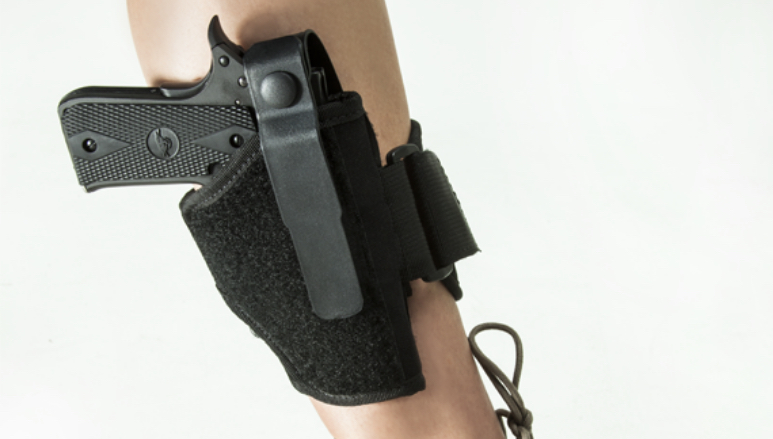
Ankle Concealed Carry Holsters
For years, police officers across the country and around the globe have been using ankle concealed carry holsters as a method for carrying a secondary pistol on their person at all times. Ankle holsters work well for covert concealed carrying, because loose pantlegs generally make for more free-flowing fabric to cover your gun. Ankle holsters have the added benefit of storing your sidearm lower on the body where people are less likely to see it if you do end up printing. The obvious drawback to an ankle holster is the fact that its lower position naturally places it further from the hands of the shooter. While this may be worrisome for some carriers, it offers a distinct tactical advantage when seated or kneeling—which may prove worthwhile for shooters who spend a significant portion of their day in a seated position. That being said, it is much more difficult and uncomfortable to conceal larger pistols with an ankle holster, so sticking with a micro or sub-compact pistol such as the Baby Rock is recommended.
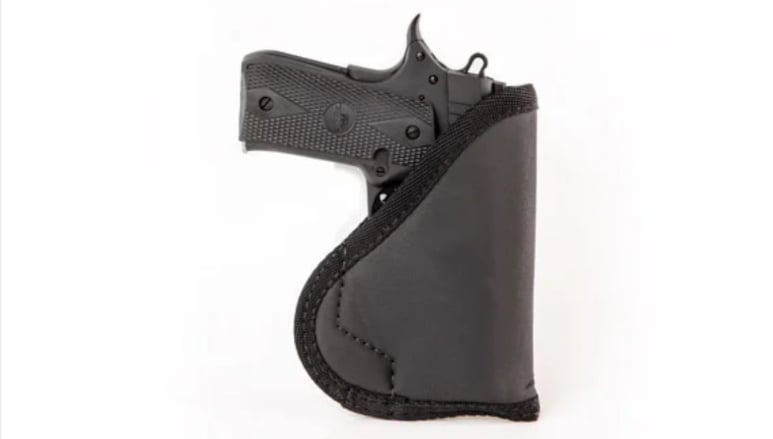
Pocket Concealed Carry Holsters
Much like the ankle holster mentioned above, pocket concealed carry holsters are an excellent solution for shooters whose body type or everyday clothing effectively prevents them from carrying their pistol in a waistband holster. As their name suggests, these holsters allow shooters to safely carry their everyday carry with them in their pocket. As with the ankle holster, pocket holsters are generally more forgiving of smaller frame pistols like the Baby Rock. One element that is unique to pocket holsters is the possibility that the holster will come out of your pocket with your firearm when you draw it for defensive use. While pocket holsters are generally made to have exterior surfaces that will grip the inside of your pocket on your draw, you can never be certain that the grip surface will successfully strip the holster from your firearm. Some pocket holsters come with thumb breaks or other unique elements that allow the shooter to manually release the gun from its holster.
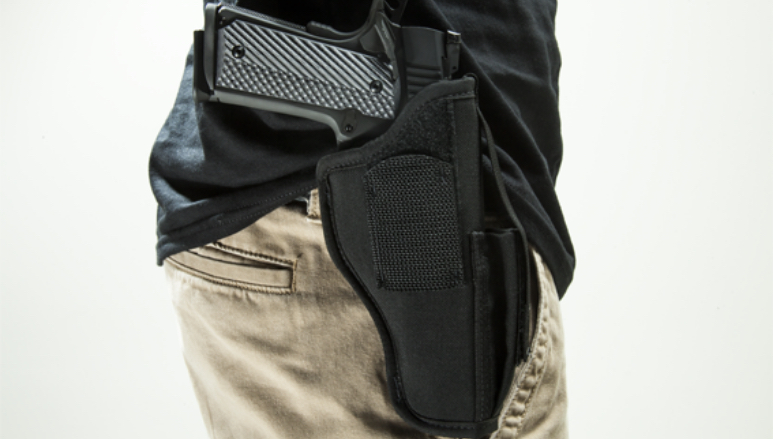
OWB Concealed Carry Holsters
Outside the waistband (OWB) concealed carry holsters are more popular among open carry shooters, but using an OWB holster for concealed carry is far from unheard of. Generally speaking, these holsters are worn at the hip and can print easily under your clothing due to their increased distance from your body. To combat this, shooters who opt for an OWB holster will often seek out a slimmer holster with a lower profile to avoid unnecessary printing.
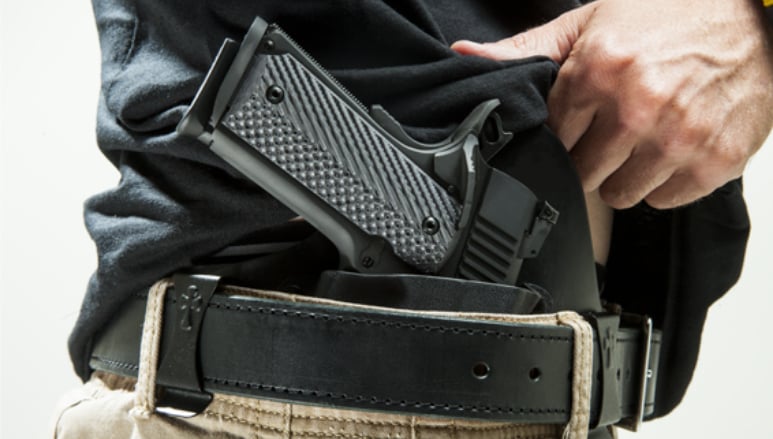
IWB Concealed Carry Holsters
Inside the waistband (IWB) concealed carry holsters are a broad category of holster that encompass many of the other options listed here. As the name would imply, these holsters are carried on the inside of a shooter’s waistband—effectively concealing most of the gun and holster behind the fabric of the shooter’s pants. Additionally, the nature of an IWB holster allows the gun to be held closer to the shooter’s body—limiting printing and maximizing concealment.
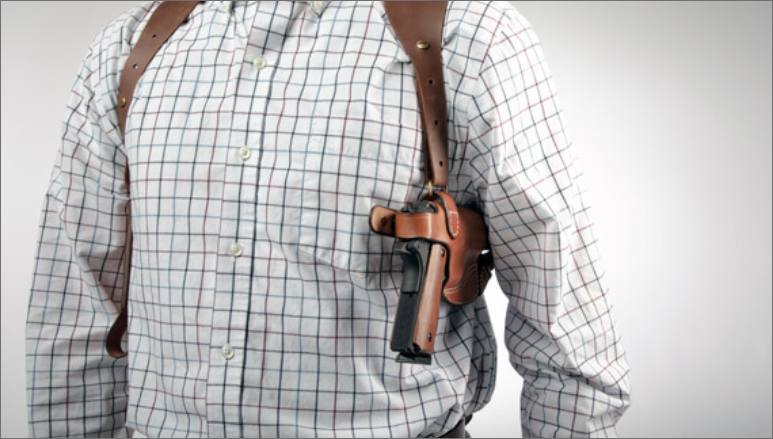
Shoulder Concealed Carry Holsters
Made famous by old-school cop dramas, the shoulder concealed carry holster is a classic American holster that allows for comfortable and convenient concealed carry of larger firearms. With the weight of your firearm supported by the shoulder straps, the shoulder holster is notably more comfortable and less intrusive than other holster options that suspend your weapon’s weight from one or two clips. The obvious drawback of a shoulder holster is that, unless you are wearing a business suit or a jacket of some sort, your firearm is not concealed. For people who wear suits every day or live in colder climates, the shoulder holster allows the wearer to carry a second firearm or additional magazines under their strong arm—which allows for additional firepower whenever it’s needed. The shoulder holster’s underarm position allows shooters to easily conceal larger handguns, such as full- or government-sized 1911s. Learn more about four popular concealed carry positions.
Concealed Carry Guns: Putting it all together
Regardless of what gun you choose, it’s important to follow the letter of the law. Concealed carry laws vary from state to state. Just because you are legally allowed to carry concealed in your home state does not mean that your right will be recognized in another. Before you travel, make sure to double-check what states your permit is valid in, and remember to maintain concealed carry insurance in case you ever need to use your gun to protect yourself or others.
We recommend checking out Armed Citizens Legal Defense Network (ACLDN), NRA Carry Guard, United States Concealed Carry Association (USCCA) or U.S. Law Shield. The 1911 is a classic platform that has protected American lives both at home and overseas. Its battle-tested durability and reliability have proven the gun’s ability to take a beating without malfunctioning.
This, coupled with the modern technologies implemented in the 1911s of today, make this platform a clear winner when it comes to workhorse concealed carry options.
Want to learn more about concealed carry pistols because you’re not ready to pull the trigger just yet? Your first step is always to ask yourself: What purpose will your concealed carry pistol serve?